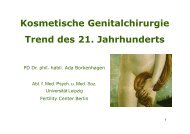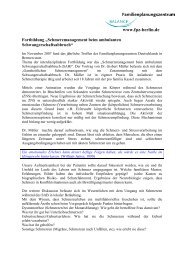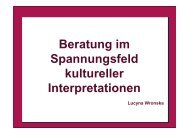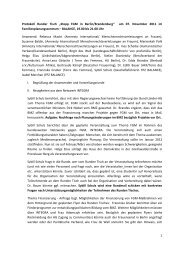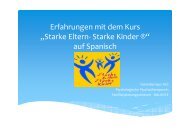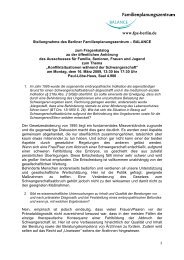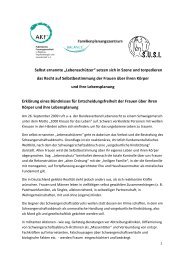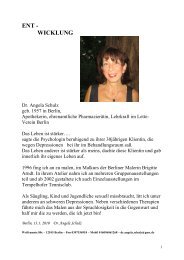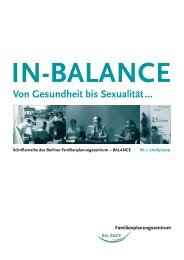and I did not succeed in satisfying her over two hours soI have preferred ever since <strong>to</strong> be with non-circumcisedwomen.” (man of Ivorian origin)Other frequently cited consequences were infections (33%),difficulties during delivery for the mother and the baby(25%) and the risk of death (23%). Some participants alsoperceived that the medical risks where exaggerated by Europeansand admitted only that the equipment used during theprocedure should be improved.“It is the Europeans who say that there are disadvantagesbecause of the equipment used <strong>to</strong> perform it. Imean when you take the same non-disinfected blade orknife for three or four girls, it can lead <strong>to</strong> illnesses of thegenitals, but the advantage that we consider more is thatfemale circumcision stabilises a lot of marriages in Africa.”(man, key informant of Ivorian origin)5.5.6.7. Knowledge of German law and attitudes <strong>to</strong>wards theabandonment of FGM/CThere was a strong awareness about the position takenby German law on the subject: 95 out of 110 participantswere informed that the practice of FGM/C is not allowed inGermany. A minority of 15 persons reported either that thelaw did not explicitly mention FGM/C or were unsure aboutFGM/C being punishable in Germany.All the women pronounced themselves in favour of s<strong>to</strong>ppingFGM/C. Most of the men (86%) expressed the sameopinion.“Yes, female circumcision exists. It is a practice inheritedfrom our ances<strong>to</strong>rs. I witnessed it for the last time in1990. After that it s<strong>to</strong>pped. I forbid my parents <strong>to</strong> carryon with it as it is harmful <strong>to</strong> women.” (man of Ivorianorigin)Only one man argued for the continuation of the practiceand seven men perceived that “it depends” on the situation.There were also five men who were indecisive regarding thecontinuation the practice. Some perceived that FGM/C wasput in a bad light by Europeans who dramatised the negativeoutcomes, which could be controlled by confining thepractice <strong>to</strong> health professionals.“Personally, I think that the Europeans try <strong>to</strong> demonisefemale circumcision. But for us it is a tradition that is <strong>to</strong>be respected. When I was born I found it going on, sodid my father, my grandfather and my great-grandfatherso I believe that we cannot – all of a sudden and out ofthe blue – wipe out this tradition, do you understand?On the other hand, I can understand that people criticisethe equipment [instruments for cutting]. There is a need<strong>to</strong> make the people understand that they need <strong>to</strong> changeinstruments, that they need <strong>to</strong> use good equipment, cleanequipment. That is something that I can understand.Apart from that it is a tradition that should be continued.[…] While living in Europe, I comply with the law and I amagainst practicing female circumcision. According <strong>to</strong> theway of living here, female circumcision is not allowed: becausethis is their way of doing it and we are not at homehere. But in Africa, female circumcision will continuedespite all efforts that the Europeans might make.” (manof Ivorian origin)“I believe that this <strong>to</strong>pic needs <strong>to</strong> be seriously discussed.Is female circumcision really as bad as the Europeans pretendit is? Isn’t there a possibility of carrying out femalecircumcision under the control of medical personnel?”(man of Ivorian origin)5.5.7. Kenya5.5.7.1. Socio-demographic profileThe Kenyan community is the only immigrant populationfrom Sub-Saharan Africa in Hamburg with a much highernumber of women than men. Out of the 285 registered Kenyansin Hamburg, 208 are women and 77 are men. We interviewedabout 20% of the Kenyan immigrants during thequantitative phase, more precisely 40 women and 15 men.This sample is not statistically representative. The educationlevel of the interviewees is generally high: all participantshad at least 10 years of formal education.5.5.7.2. Proportion of immigrant population concernedIt is estimated that about 27% of the women in Kenya haveundergone FGM/C. The practice is most established in theNorth Eastern region where over 95% of the women areconcerned, followed by the Central, Eastern, Nyanza and RiftValley region where the proportions of women concernedvary between 25-36%. The remaining regions have lowernumbers. The ethnic group affiliation is also a good markerin Kenya. While FGM/C is unknown among the Luo, Luyhaand Swahili, it is quasi universal among the Kisii and the Somali(over 95% of them have undergone FGM/C). Anotherhighly affected group are the Massai (73%). The Kikuyu,Embu, Taita, Kalenjin, Kamba and Meru are partly practicinggroups with prevalence rates ranging from 21-51% (KenyaNational Bureau of Statistics and ICF Macro 2010).The interviewees came from all the regions in Kenya withthe exception of the North Eastern region (which has thehighest FGM/C prevalence). There were 14 participants fromNairobi, 12 from the Central region, 9 from Nyanza, 7 from<strong>Listening</strong> <strong>to</strong> <strong>African</strong> <strong>Voices</strong> 61
Table 31: Socio-demographic characteristics of immigrants from KenyaSocio-demographicvariableswomen(n = 40)men(n = 15)<strong>to</strong>tal sample(n = 55)Age (in years)Mean (standard deviation) 29.4 (6.4) 28.9 (9.0) 29.2 (7.3)Range 19-49 19-48 19-49Average education level (in years)Mean (standard deviation) 14.6 (2.7) 15.2 (1.8) 14.7 (2.5)Range 10-21 13-19 10-21ReligionMuslim 2 (5.0%) 3 (20.0%) 5 (9.1%)Christian 37 (92.5%) 12 (80.0%) 49 (89.1%)Traditional religion 0 (0.0%) 0 (0.0%) 0 (0.0%)None believers 1 (2.5%) 0 (0.0%) 1 (1.8%)Social statusMarried (monogamous) 5 (12.5%) 3 (20.0%) 8 (14.5%)Separated/divorced/widowed 6 (15%) 2 (13.3%) 8 (14.5%)Never been married 22 29 (72.5%) 10 (66.7%) 39 (71.0%)Migrated from a(n)Urban area 32 (84.2%) 13 (86.7%) 45 (84.9%)Rural area 6 (15.8%) 2 (13.3%) 8 (15.1%)Residence statusUnbefristet (indefinite residence permission) 12 (30.0%) 4 (26.7%) 16 (29.1%)Befristet (temporary residence permission) 22 (55.0%) 8 (53.3%) 30 (54.5%)Duldung (<strong>to</strong>leration) 1 (2.5%) 0 (0.0%) 1 (1.8%)Others/no papers/does not answer 4 (10%) 0 (0.0%) 4 (7.3%)German nationality 1 (2.5%) 20 (20.0%) 4 (7.3%)Time spent in Germany (in months)Mean (standard deviation) 72.5 (51.3) 78.7 (47.6) 74.2 (50.0 %)Range 3-240 13-168 3-240the Western, 6 from the Coast and 4 from Rift Valley region.There were 14 different ethnic groups (e.g. Kikuyu, Kalenjinand Luo) among the men and women interviewed. The ethnicgroups most devoted <strong>to</strong> the practice were underrepresented;there were three Kisii and three Massai participantsbut no Somali participants. These findings indicate that theKenyan immigrant population does not have a distinct profilewith dominating ethnic groups or areas of origin.Almost half of the participants reported that FGM/C havebeen practiced in their family (46%). Three further participants,two men and one woman expressed uncertainty as <strong>to</strong>whether or not FGM/C existed in their family. Men were lesslikely <strong>to</strong> come from practicing families than women.5.5.7.3. Women and girls concernedOut of the 40 Kenyan women interviewed, eight reported<strong>to</strong> have undergone FGM/C, two women preferred not <strong>to</strong>share their status and 30 women answered in the negative.Interviewers noted doubts for three of the 30 women whoanswered in the negative due <strong>to</strong> their non-verbal reactions<strong>to</strong> the question.The women concerned reported that the practice was carriedout between 0 and 12 years of age by traditional practitionersin Kenya. One woman claimed <strong>to</strong> have undergonean infibulation. Migration helped two women <strong>to</strong> escape fromthe practice. One of them was staying with her mother’s relativesfrom a non-practicing group in another area while hersisters underwent FGM/C. She later migrated <strong>to</strong> Germany.The second woman gave the following testimony:“I was almost circumcised 10 years ago in Kenya, butsince my mother was already in Germany, I had the opportunity<strong>to</strong> come here before it happened. It was mygrandmother who insisted that the practice be carriedout.” (woman of Kenyan origin)The cohort of daughters was small. Nine of the participantswere parents <strong>to</strong> a <strong>to</strong>tal of 14 daughters, 9 of which wereliving in Hamburg. None of the daughters had undergone62<strong>Listening</strong> <strong>to</strong> <strong>African</strong> <strong>Voices</strong>





